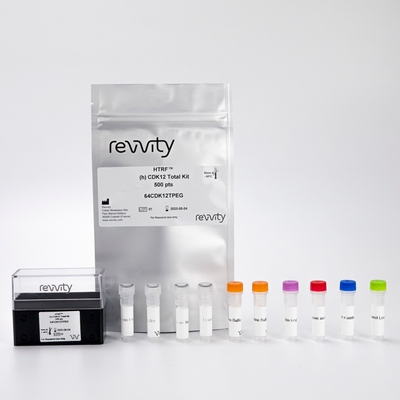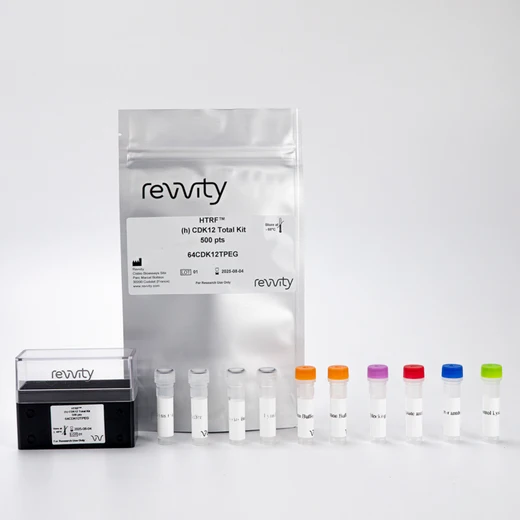

HTRF Human Total CDK12 Detection Kit, 500 Assay Points


HTRF Human Total CDK12 Detection Kit, 500 Assay Points






The HTRF Human IRF5 Detection kit is designed to detect the expression level of IRF5 in cell lysates.
For research use only. Not for use in diagnostic procedures. All products to be used in accordance with applicable laws and regulations including without limitation, consumption and disposal requirements under European REACH regulations (EC 1907/2006).
| Feature | Specification |
|---|---|
| Application | Cell Signaling |
| Sample Volume | 16 µL |
The HTRF Human IRF5 Detection kit is designed to detect the expression level of IRF5 in cell lysates.
For research use only. Not for use in diagnostic procedures. All products to be used in accordance with applicable laws and regulations including without limitation, consumption and disposal requirements under European REACH regulations (EC 1907/2006).



HTRF Human Total CDK12 Detection Kit, 500 Assay Points



HTRF Human Total CDK12 Detection Kit, 500 Assay Points



Product information
Overview
The Total CDK12 cellular assay monitors CDK12 protein levels.
CDK12 is a transcription-associated CDK. It complexes with cyclin K to regulate gene transcription elongation via the phosphorylation of RNA polymerase II (RNAP II), and also regulates translation. Moreover, CDK12 plays a role in RNA splicing, cell cycle progression, cell proliferation, DNA damage response (DDR), and the maintenance of genomic stability. Since the mutation or amplification of CDK12 is closely related with tumorigenesis, CDK12 has become an attractive therapeutic target for cancer treatments.
Specifications
| Application |
Cell Signaling
|
|---|---|
| Automation Compatible |
Yes
|
| Brand |
HTRF
|
| Detection Modality |
HTRF
|
| Lysis Buffer Compatibility |
Lysis Buffer 2
|
| Molecular Modification |
Total
|
| Product Group |
Kit
|
| Sample Volume |
16 µL
|
| Shipping Conditions |
Shipped in Dry Ice
|
| Target Class |
Phosphoproteins
|
| Target Species |
Human
|
| Technology |
TR-FRET
|
| Therapeutic Area |
Oncology & Inflammation
|
| Unit Size |
500 Assay Points
|
Video gallery

HTRF Human Total CDK12 Detection Kit, 500 Assay Points

HTRF Human Total CDK12 Detection Kit, 500 Assay Points

How it works
Total CDK12 assay principle
The Total CDK12 assay quantifies the expression level of CDK12 in a cell lysate. Unlike Western Blot, the assay is entirely plate-based and does not require gels, electrophoresis, or transfer. The Total CDK12 assay uses two labeled antibodies, one coupled to a donor fluorophore and the other to an acceptor. Both antibodies are highly specific for a distinct epitope on the protein. In the presence of CDK12 in a cell extract, the addition of these conjugates brings the donor fluorophore into close proximity with the acceptor and thereby generates a FRET signal. Its intensity is directly proportional to the concentration of the protein present in the sample, and provides a means of assessing the protein's expression under a no-wash assay format.

Total CDK12 two-plate assay protocol
The two-plate protocol involves culturing cells in a 96-well plate before lysis, then transferring lysates into a 384-well low volume detection plate before the addition of Total CDK12 HTRF detection reagents. This protocol enables the cells' viability and confluence to be monitored.

Total CDK12 one-plate assay protocol
Detection of Total CDK12 with HTRF reagents can be performed in a single plate used for culturing, stimulation, and lysis. No washing steps are required. This HTS designed protocol enables miniaturization while maintaining robust HTRF quality.

Assay validation
Validation of the specificity of Total CDK12 assay by siRNA experiments
HeLa cells were plated in 96-well plates (50,000 cells/well) and cultured for 24h. The cells were then transfected with siRNAs specific for CDK1, CDK2, CDK4, CDK6, CDK7, CDK9, or CDK12, as well as with a negative control siRNA. After a 48h incubation, the cells were lyzed and 16 µL of lysates were transferred into a 384-well low volume white microplate before the addition of 4 µL of the HTRF Total CDK12 detection antibodies. An additional 4 µL of lysates (supplemented with 12 µL diluent #11) was also transferred into the microplate to monitor GAPDH level using the GAPDH Housekeeping Cellular Kit (64GAPDHPET/G/H). HTRF signals for both kits were recorded after an overnight incubation.
Cell transfection with CDK12 siRNA led to a 90% signal decrease compared to the cells transfected with the negative siRNA. No signal decrease was observed for cells transfected with CDK1, CDK2, CDK4, CDK6, CDK7, or CDK9 siRNAs. The level of GAPDH measured remained unchanged under all the conditions tested. The data demonstrate that the HTRF Total CDK12 is specific for the detection of CDK12 protein and does not cross-react with other CDK family members.


Assessment of total CDK12 levels in various cell lines
Various cell lines, either adherent HeLa, HEK293, SHSY5Y cells or suspension, such as K562 cells, were seeded at 200,000 cells / well in a 96-well microplate. After a 24H incubation, the cells were lyzed with supplemented lysis buffer, and 16 µL of lysate were transferred into a 384-well low volume white microplate before the addition of 4 µL of the HTRF Total CDK12 detection reagents. The HTRF signal was recorded after an overnight incubation.

Total CDK12 degradation using CDK12 Protac
HeLa cells were seeded in a 96-well culture-treated plate under 200,000 cells / well in complete culture medium, and incubated for 6H at 37 ° C, 5% CO2. The cells were then treated with Vehicle (DMSO), CDK12 Protac (BSJ-4-116), CDK12 Binder (THZ531), CRBN Binder (Thalidomide), or an Irrelevant Protac at 100 nM for 16H at 37°C, 5% C02. After cell lysis with 50 µL of supplemented lysis buffer #2, the same lysate was sequentially dispensed into a low volume detection white plate: 16 µL for Total CDK12 and an additional 4 µL (supplemented with 12 µL diluent #11) to check GAPDH levels using the HTRF GAPDH Housekeeping kit (64GAPDHPET/G/H). The corresponding kit detection reagents were added under 4 µL, and HTRF signals were recorded after an overnight incubation. The CDK12 Protac (BSJ-4-116) induced CDK12 protein degradation with an 82% signal decrease compared to the cells treated with Vehicle (DMSO). No signal decrease was observed for cells treated with CDK12 Binder, CRBN Binder, or an Irrelevant Protac. The level of GAPDH measured remained unchanged under all the conditions tested (no cytotoxicity).


Total CDK12 degradation on HeLa and K562 cells
HeLa and K562 cells were seeded in a 96-well culture-treated plate under 200,000 cells / well in complete culture medium, and incubated for 6H at 37 ° C, 5% CO2. The cells were then treated with increasing concentrations of CDK12 Protac (BSJ-4-116) for 16H at 37°C-5%CO2. After cell lysis, the same lysate was sequentially dispensed into a low volume detection white plate: 16 µL for Total CDK12 and an additional 4 µL (supplemented with 12 µL diluent #11) to check GAPDH levels using the HTRF GAPDH Housekeeping kit (64GAPDHPET/G/H). The corresponding kit detection reagents were added under 4 µL and HTRF signals were recorded after an overnight incubation.
As expected, the results obtained show a dose-response degradation of Total CDK12 in HeLa and K562 cells after treatment with CDK12 Protac (half maximal degradation of 40 nM and 58nM respectively), while the level of GAPDH remained constant.


HTRF total CDK12 assay compared to Western Blot
K562 cells were cultured in a T175 flask in complete culture medium at 37°C-5% CO2. After a 48h incubation, the cells were lysed with 3 mL of supplemented lysis buffer #2(1X) for 30 minutes at RT under gentle shaking.
Serial dilutions of the cell lysate were performed using supplemented lysis buffer, and 16 µL of each dilution were transferred into a low volume white microplate before the addition of 4 µL of HTRF total CDK12 detection reagents. Equal amounts of lysates were used for a side by side comparison between HTRF and Western Blot.
Using the HTRF total CDK12 assay, 1200 cells/well were enough to detect a significant signal, while 3600 cells were needed using Western Blot with an ECL detection. Therefore in these conditions, the HTRF total CDK12 assay is 3 times more sensitive than the Western Blot technique.

Simplified pathway
Role of CDK12 in the cell-division cycle
CDKs are traditionally separated into 2 subfamily members: CDKs that coordinate cell cycle progression (CDK1, CDK2, CDK4, and CDK6) and transcriptional CDKS (CDK7, CDK8, CDK9, CDK12, and CDK13).
CDK12 (cyclin dependant kinase 12) forms a complex with cyclin K that regulates phosphorylation of the C-terminal domain (CTD) of RNA polymerase II. CDK12 regulates the expression of genes involved in DNA repair and is required for the maintenance of genomic stability.

Resources
Are you looking for resources, click on the resource type to explore further.
Discover the versatility and precision of Homogeneous Time-Resolved Fluorescence (HTRF) technology. Our HTRF portfolio offers a...


How can we help you?
We are here to answer your questions.






























